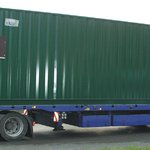The AS-ISO MBR line of wastewater treatment plants is designed for the treatment of municipal wastewater. The treatment plant use aerobic treatment technology together with membrane separation of activated sludge from cleaned water. The plants are designed to achieve the best cleaning performance. The water cleaned in this way can be further reused as irrigation or service water.
Advantages of the AS-ISO MBR
- Cleaned water can be further used as irrigation (sevice) water
- Compact mobile design for wastewater treatment
- The design includes all operating sections – all included in the price
- Insulated, lockable container
- Customer support & services
- Only minimum of builder’s works in connection (building preparations) are needed
- Easy handled and reliable operations
- Aboveground self-supporting structure
- Possibility of on-site chemical cleaning of membranes
Practical application of AS-ISO MBR
- Low discharge concentrations of impurities in cleaned water enable to use this water for irrigation purposes or to discharge it in protected areas, or for wastewater treatment applications in tourist-intensive areas, national parks, etc.
- The plant meets temporary requirements for wastewater treatment such as seasonal accommodation facilities, camps, tourism localities, etc.
- Confined conditions, restricted space – both external and internal.
- Low capital expenditures are required for the building part of the wastewater treatment plant.
Process description of the technology:
Wastewater is pumped into the mechanical pre-treatment compartment (A), where floating and sedimentable solids of diameters larger than 1 mm are removed. From the mechanical pre-treatment compartment, the wastewater stream flows through the overflow to the balancing reservoir and from there it is pumped into the activation tank. In the activation tank (B), impurities are removed under oxic conditions. Thus, if needed, this space can be used alternately under oxic and anoxic conditions or it can be used as an accumulation tank, as necessary. From the activation tank, the water stream is pumped with a submerged pump (E) into the filtration tank (C), which accommodates membrane modules (D). At the same time, the filtration tank is used for biological treatment of wastewater and ultrafiltration through the membranes.
The treatment plant is provided with an aeration system, which is used for wastewater aeration and, (in the filtration tank), also for cleaning of the membrane modules.

Installation of the treatment plants
The treatment plants are installed on a concrete base plate with prepared connections of pipeline systems. Except for the connection of the power supply and possibly the control elements of adjacent structures, the treatment plants do not require any electric installation work. The wastewater treatment plant is put in operation by the supplier or an authorized service organization. With regard to the installation of the technology in ISO containers, the treatment plants are transportable both by truck and by boat. In the place of installation, the openings for pipe passages and ventilation openings must be cut out of the walls of the ISO containers.
Maintenance
Maintenance is carried out by authorized service centres.
Maintenance of the membranes and the setting of the extraction of excess sludge is carried out as necessary, in accordance with the operating rules, by trained operators of the wastewater treatment plant. The membranes are generally cleaned or replaced once every half a year.
Guarantee
WWTP technology - 24 months; tanks - 5 years.
Documentation
Together with the purchase agreement, the customer will receive the Operating and Installation Documentation. The customer will receive the remaining WWTP documentation together with the guarantee certificate (Operations Diary, Operating Instructions, and Draft of the Operating Rules).






